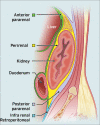Retroperitoneal anatomy with the aid of pathologic fluid: An imaging pictorial review
- PMID: 38205277
- PMCID: PMC10778072
- DOI: 10.25259/JCIS_79_2023
Retroperitoneal anatomy with the aid of pathologic fluid: An imaging pictorial review
Abstract
The retroperitoneum, a complex anatomical space within the abdominopelvic region, encompasses various vital abdominal organs. It is compartmentalized by fascial planes and contains potential spaces critical in multiple disease processes, including inflammatory effusions, hematomas, and neoplastic conditions. A comprehensive understanding of the retroperitoneum and its potential spaces is essential for radiologists in identifying and accurately describing the extent of abdominopelvic disease. This pictorial review aims to describe the anatomy of the retroperitoneum while discussing commonly encountered pathologies within this region. Through a collection of illustrative images, this review will provide radiologists with valuable insights into the retroperitoneum, facilitating their diagnostic proficiency to aid in appropriate patient clinical management.
Keywords: Anatomy; Extraperitoneal spaces; Pathologic fluid; Retroperitoneal spaces; Retroperitoneum.
© 2023 Published by Scientific Scholar on behalf of Journal of Clinical Imaging Science.
Conflict of interest statement
There are no conflicts of interest.
Figures

















Similar articles
-
Intraperitoneal anatomy with the aid of pathologic fluid and gas: An imaging pictorial review.J Clin Imaging Sci. 2023 May 19;13:13. doi: 10.25259/JCIS_29_2023. eCollection 2023. J Clin Imaging Sci. 2023. PMID: 37292244 Free PMC article.
-
Retroperitoneum revisited: a review of radiological literature and updated concept of retroperitoneal fascial anatomy with imaging features and correlating anatomy.Surg Radiol Anat. 2024 Aug;46(8):1165-1175. doi: 10.1007/s00276-024-03432-8. Epub 2024 Jul 4. Surg Radiol Anat. 2024. PMID: 38963431 Free PMC article. Review.
-
The Peritoneum: Anatomy, Pathologic Findings, and Patterns of Disease Spread.Radiographics. 2024 Aug;44(8):e230216. doi: 10.1148/rg.230216. Radiographics. 2024. PMID: 39088361 Review.
-
Understanding Retroperitoneal Anatomy for Lateral Approach Spine Surgery.Spine Surg Relat Res. 2017 Dec 20;1(3):107-120. doi: 10.22603/ssrr.1.2017-0008. eCollection 2017. Spine Surg Relat Res. 2017. PMID: 31440621 Free PMC article. Review.
-
Surgical anatomy of the retroperitoneal spaces--part I: embryogenesis and anatomy.Am Surg. 2009 Nov;75(11):1091-7. Am Surg. 2009. PMID: 19927512 Review.
References
-
- Quaia E, Gennari AG. Radiological imaging of the kidney. Berlin, Heidelberg: Springer Berlin Heidelberg; 2014. Normal radiological anatomy of the retroperitoneum; pp. 75–9. - DOI
-
- Lambert G, Samra NS. StatPearls. Treasure Island, FL: StatPearls Publishing; 2023. Anatomy, abdomen and pelvis, retroperitoneum. - PubMed
-
- Mindell HJ, Mastromatteo JF, Dickey KW, Sturtevant NV, Shuman WP, Oliver CL, et al. Anatomic communications between the three retroperitoneal spaces: Determination by CT-guided injections of contrast material in cadavers. AJR Am J Roentgenol. 1995;164:1173–8. doi: 10.2214/ajr.164.5.7717227. - DOI - PubMed
Publication types
LinkOut - more resources
Full Text Sources
